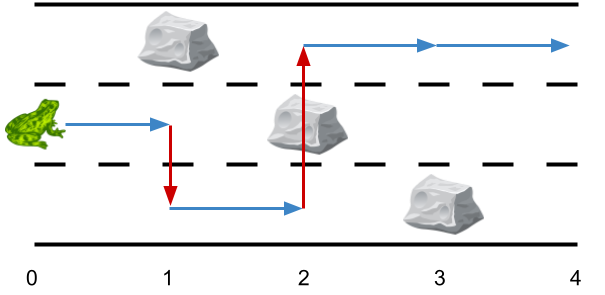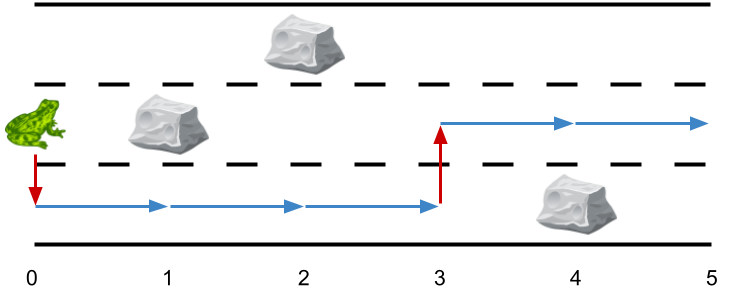1824. Minimum Sideway Jumps


Description
There is a 3 lane road of length n that consists of n + 1 points labeled from 0 to n. A frog starts at point 0 in the second lane and wants to jump to point n. However, there could be obstacles along the way.
You are given an array obstacles of length n + 1 where each obstacles[i] (ranging from 0 to 3) describes an obstacle on the lane obstacles[i] at point i. If obstacles[i] == 0, there are no obstacles at point i. There will be at most one obstacle in the 3 lanes at each point.
- For example, if
obstacles[2] == 1, then there is an obstacle on lane 1 at point 2.
The frog can only travel from point i to point i + 1 on the same lane if there is not an obstacle on the lane at point i + 1. To avoid obstacles, the frog can also perform a side jump to jump to another lane (even if they are not adjacent) at the same point if there is no obstacle on the new lane.
- For example, the frog can jump from lane 3 at point 3 to lane 1 at point 3.
Return the minimum number of side jumps the frog needs to reach any lane at point n starting from lane 2 at point 0.
Note: There will be no obstacles on points 0 and n.
Example 1:

Input: obstacles = [0,1,2,3,0] Output: 2 Explanation: The optimal solution is shown by the arrows above. There are 2 side jumps (red arrows). Note that the frog can jump over obstacles only when making side jumps (as shown at point 2).
Example 2:

Input: obstacles = [0,1,1,3,3,0] Output: 0 Explanation: There are no obstacles on lane 2. No side jumps are required.
Example 3:

Input: obstacles = [0,2,1,0,3,0] Output: 2 Explanation: The optimal solution is shown by the arrows above. There are 2 side jumps.
Constraints:
obstacles.length == n + 11 <= n <= 5 * 1050 <= obstacles[i] <= 3obstacles[0] == obstacles[n] == 0
Solution
class Solution:
def minSideJumps(self, obs: List[int]) -> int:
n = len(obs)
lanes = [[True] * n for _ in range(3)]
for i,x in enumerate(obs):
if x != 0:
lanes[x - 1][i] = False
suffix = [[1] * n for _ in range(3)]
for i in range(3):
for j in reversed(range(n)):
if not lanes[i][j]:
suffix[i][j] = 0
else:
if j != n - 1:
suffix[i][j] += suffix[i][j + 1]
curr = 1
jumps = 0
for i in range(n-1):
if not lanes[curr][i+1]:
lane1 = suffix[0][i] if curr != 0 and lanes[0][i] else float('-inf')
lane2 = suffix[1][i] if curr != 1 and lanes[1][i] else float('-inf')
lane3 = suffix[2][i] if curr != 2 and lanes[2][i] else float('-inf')
m = max(lane1, lane2, lane3)
if m == lane1:
curr = 0
elif m == lane2:
curr = 1
else:
curr = 2
jumps += 1
return jumps